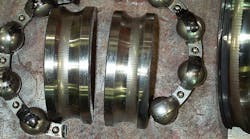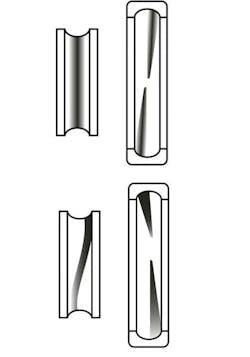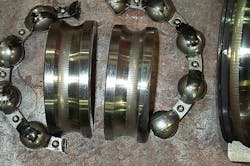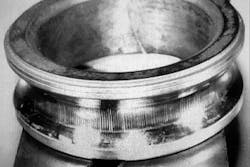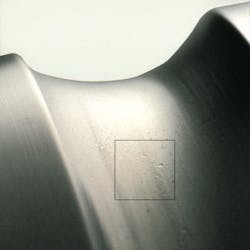Many of you have good in-house predictive maintenance departments, and others outsource that work to others. Either way, you routinely know when a bearing is deteriorating, and remove the motor from service before it turns into a catastrophic failure. That saves a lot of maintenance dollars, which is great. But if you stop there — without discovering why that bearing is faulty — you could be facing the same problem again in a few short weeks or months. Bad bearings often hold a great deal of evidence, if you know what items to focus on.
Diagonal wear paths indicate misalignment. The load zone of the bearing at top, shown as shadowed path, indicates that the outer race is misaligned to the shaft. The load zone of the bearing at bottom indicates the inner race is misaligned relative to the housing.
Follow the clues
Whether the investigation is done in-house or by your service center, here are the steps you should follow to make sure you don’t miss important clues.
- Mark the bearings to indicate which end of the motor (or generator, pump, blower, etc.) each came from. By marking the side facing out, you also will know the orientation of both bearings.
- Dismantle the bearing. The easiest way to do this is to cut the outer race in half with a die grinder. Another option is to use a grinder to remove the rivet heads that hold the bearing retainer together.
- Wipe the grease out of the inner and outer races, and examine the ball wear paths to determine the cause of the problem.
Consider the evidence
- Misalignment. A diagonal wear path indicates misalignment (Figure).
- Preloading. If the wear path is offset in opposite directions on inner versus outer race, the bearing was preloaded during service (Photo 1). Are both ends preloaded outward? That means the motor does not have sufficient room for thermal expansion of the shaft. Corrective machining is required. Only the drive end? That means the preload was due to external forces, specifically during the alignment and coupling phase. Give the millwright a heads up.
- Shaft currents and contamination. A washboard appearance called fluting (Photos 2A and 2B) is indicative of shaft currents (a.k.a. bearing currents), which are increasingly common when motors are powered by variable-frequency drives (VFDs). A highly frosted wear path is either caused by VFD-related shaft currents or dirt embedded in the grease. Use a 20x magnifier to look more closely. Electrical pitting on the race or rolling element will have a melted appearance along the edges, whereas contamination causes a rougher cratering.
Whatever you find, work with your trusted service center to solve the problem — don’t just change the bearings.
Yung is a senior technical support specialist at the Electrical Apparatus Service Association (EASA) in St. Louis. He can be reached [email protected].
